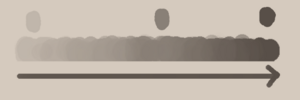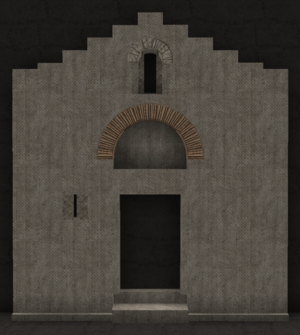Gradient Guide: Difference between revisions
No edit summary |
No edit summary |
||
| Line 26: | Line 26: | ||
=== Design principles === | === Design principles === | ||
== Techniques == | == Techniques == | ||
Before creating a gradient, it's often a good idea to begin with a blank template - wool/canvas blocks are a good option. The reasoning behind this is that it's much simpler to focus on one element of your build at a time. Moreover, gradienting can be an arduous process and it's helpful to settle on your general shape before committing your time in finalising the texture. Remember that the gradient is just the final step in the building process, and a great gradient can't save a wonky and half-baked structure! | |||
[[File:Image.png|left|thumb|Step 1: Basic canvas shape with main details]] | |||
So to begin, we have a simple canvas wall with | |||
=== Shape design === | === Shape design === | ||
Revision as of 09:28, 2 December 2023
DRAFT
At its core, gradienting is a method in the building process that adds detail to otherwise bland surfaces. In the past before recent gradient methods were developed there was an over-reliance on depth and haphazard 'splatter' texturing to create interest. In recent years however, an increasingly greater emphasis is placed on reducing depth and excessive structural detail in favour of realistically rendered gradients. The purpose of this guide is to inform the reader on how this technique is achieved.
Preliminaries:
- All in-game images used in this guide are located on the ArdaCraft server and are accessible via /warp GradientGuide. It is recommended to view these for yourself as it helps visualize the techniques explored in this guide in a more engaging way. The in-game guide follows this entry chronologically.
- If you wish to skip directly to the meat and potatoes, then start at Techniques - however beginners are advised to read the entire guide for a better understanding.
- The later sections of the guide from Applications onward focuses on practical examples and ideas. Experienced builders will find these sections especially relevant.
Overview
Gradients, blending, texturing or transitioning all refer to the same basic concept. It is a process in which one value (or tone) is transitioned to another from A -> B -> C. In drawing, this can be thought of as shading, in painting as blending, or in pixel art as dithering. No matter the medium, the goal is always to tidily transition between light and dark details to create a harmonious effect. In Minecraft we refer to this as gradienting, and it is achieved by mixing a number of blocks in a sequential order to create a seamless and tidy blend.
While the concept of blending blocks together seems simple enough, in practice it can be difficult to master. This is because factors such as block type (stones, woods, plasters etc.), colour, and CTMs affect the transition quality of a gradient. The most common way in which beginners mess up a gradient is by missing a step in the transition that could blend the blocks more thoroughly. Nothing ruins the illusion of a realistic surface quicker than noticeable blocky squares due to a poorly blended palette.
Weathering
....
Any structure that is left unattended to the elements will over time weather and deteriorate. There are varying kinds of weathering that break down structures, notably physical, chemical and biological weathering. These all have unique effects, and it helps to have a general idea of how they work.
The most common type is physical weathering where mechanical forces promote the decay of a material. Fluctuations in temperature can cause an unequal expansion and contraction, leading to cracking and warping. Likewise,
Weathering patterns
Design principles
Techniques
Before creating a gradient, it's often a good idea to begin with a blank template - wool/canvas blocks are a good option. The reasoning behind this is that it's much simpler to focus on one element of your build at a time. Moreover, gradienting can be an arduous process and it's helpful to settle on your general shape before committing your time in finalising the texture. Remember that the gradient is just the final step in the building process, and a great gradient can't save a wonky and half-baked structure!
So to begin, we have a simple canvas wall with

